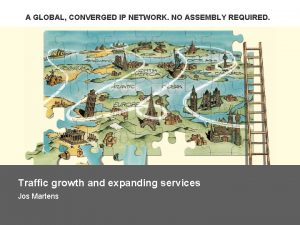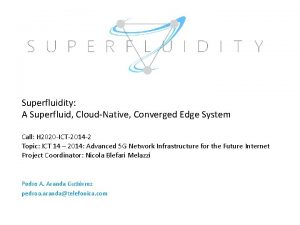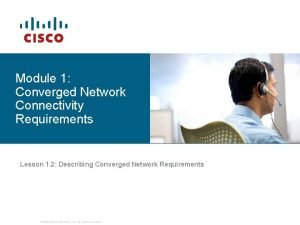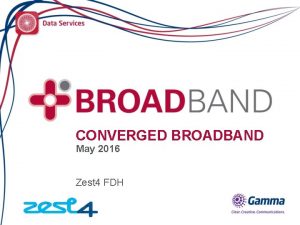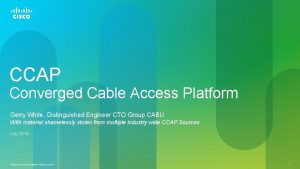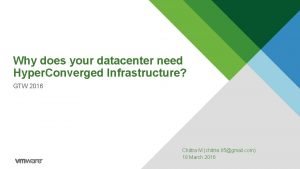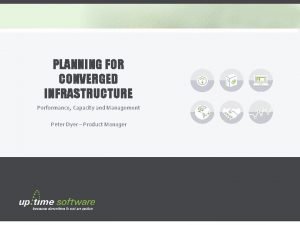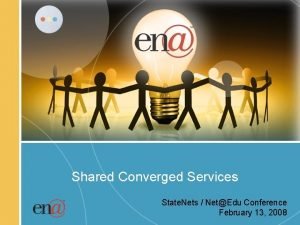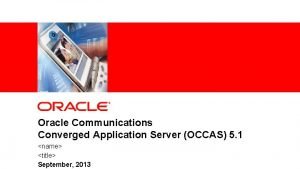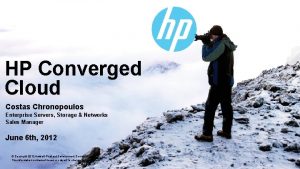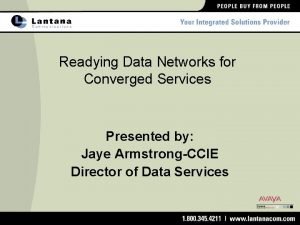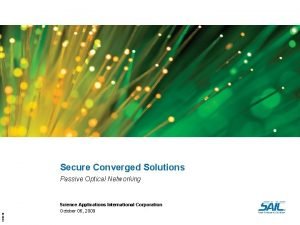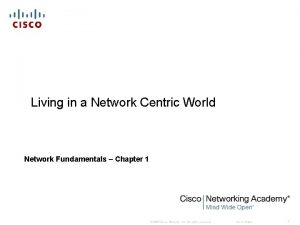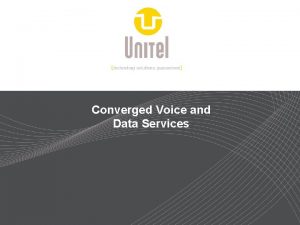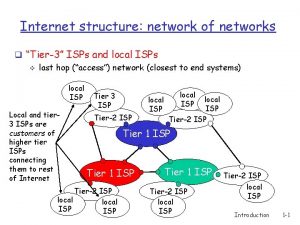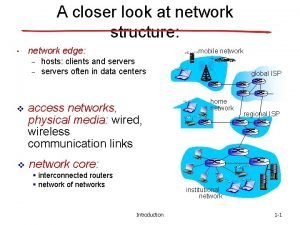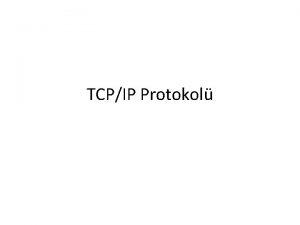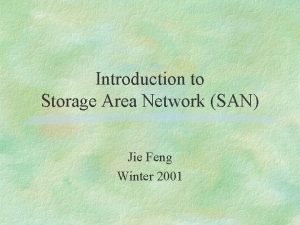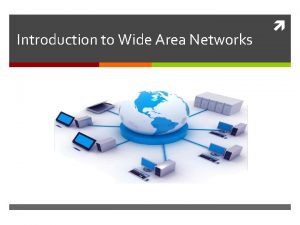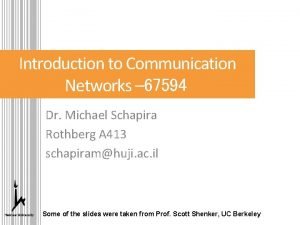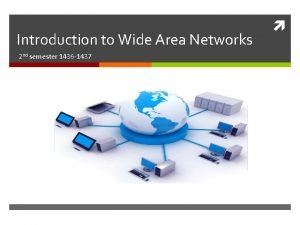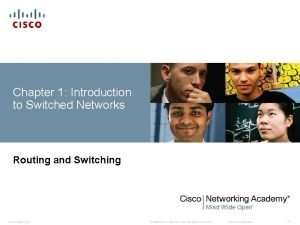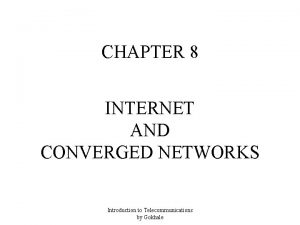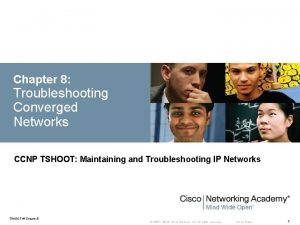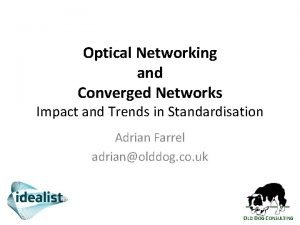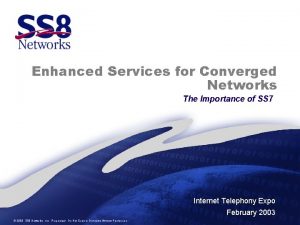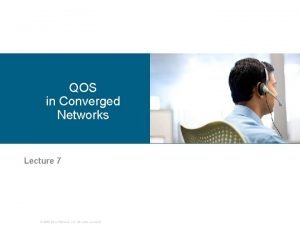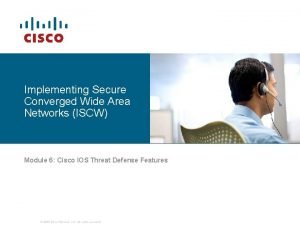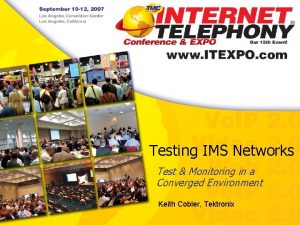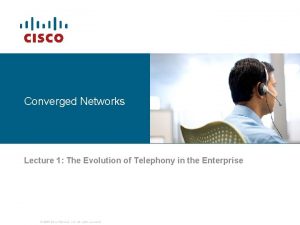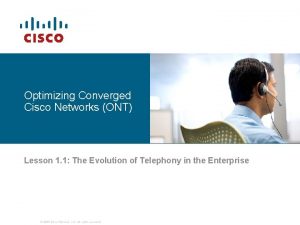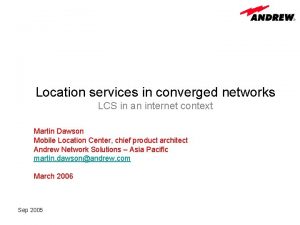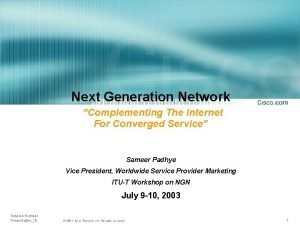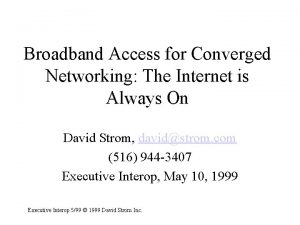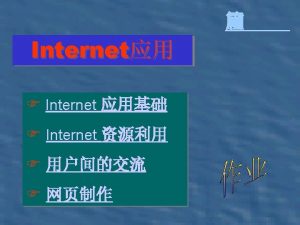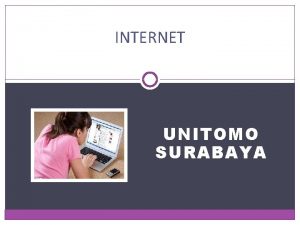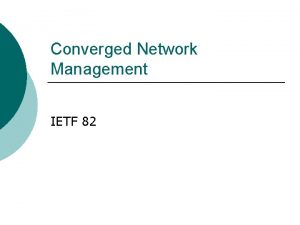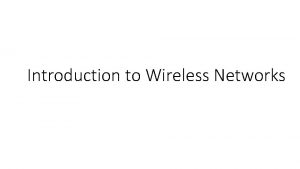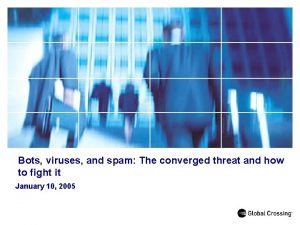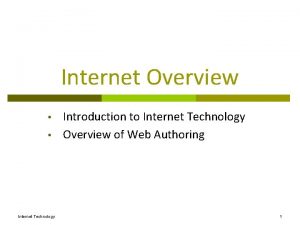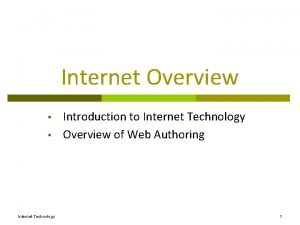CHAPTER 8 INTERNET AND CONVERGED NETWORKS Introduction to




































- Slides: 36

CHAPTER 8 INTERNET AND CONVERGED NETWORKS Introduction to Telecommunications by Gokhale

TCP/IP Model • The TCP/IP protocol suite emerged from research under the auspices of DARPA • Originally designed for the Internet but it is equally adaptable for a close network such as a LAN • The widest accepted set of protocol in the telecommunications industry, implemented in both LAN and WAN environments 2

Benefits of TCP/IP protocol • Ease with which it can be configured, managed, maintained and scaled • Higher flexibility than any other protocol • Good error-detection and recovery mechanisms • Broad appeal, especially because of the growing popularity of the Internet 3

Transmission Control Protocol (TCP) • Transmission Control protocol (TCP) is a Layer-4 (transport-layer) reliable, connection-oriented, unicast (point-to-point), guaranteed delivery protocol that performs end-to-end error checking, correction and acknowledgement – Connection-oriented means connection must be established prior to data transfer • Ensures that data is delivered error-free with no loss or duplication • Applications that use TCP include FTP (File Transfer Protocol), HTTP, TELNET and SMTP (Simple Mail Transfer Protocol) 4

User Datagram Protocol (UDP) • User Datagram Protocol (UDP), is also a Layer-4 (transport-layer) protocol like TCP. In comparison to TCP, it is an unreliable, connectionless protocol, but with less overheads – Connectionless means data transfer on a best-effort basis • Applications such as SNMP (Simple Network Management Protocol) and RTP (Real-time Transport Protocol) use UDP 5

Internet Protocol (IP) • The Internet Protocol (IP), equivalent to Layer 3, segments and packets data for transmission and then places a header for delivery. The IP header is in addition to the TCP or UDP header appended to the application data • The IP header includes the source and destination addresses, enabling an end-to-end data flow 6

Correlation Between TCP/IP and OSI Layers 7

IP Version 4 (IPv 4) Addressing • The IP version 4 (IPv 4) addressing requires a unique, 32 -bit address to be assigned to each host connected to an IP-based network. The basic addressing scheme is a two-level hierarchy, represented below: Class Network Host Two-level IP Addressing Hierarchy 8

Five Network Classes Supported in IPv 4 9

Internet Assigned Numbers Authority (IANA) • Internet Assigned Numbers Authority (IANA) is responsible for three things: – Assigning IP addresses, that is, the four octets to identify every Internet router, server and workstation – Running the root name servers that provide the essential base for the Domain Name System (DNS) – Acting as final arbiter and editor for key standards developed by the Internet Community • IANA developed the Dotted Decimal Notation – A technique used to express IP addresses via the use of four decimal numbers separated from one another by decimal points 10

Dotted Decimal Notation • Dotted Decimal Notation – Divides the 32 -bit IP address into four 8 -bit (one-byte) fields or octets, with each specified as a decimal number – The decimal number for octets 2, 3 and 4 can range from 0 to 255 – In the first octet, the setting of the first few bits for the “Class address” limits the range of decimal values 11

Domain Name Identifiers • For example the domain name www. ilstu. edu has an IP address of 138. 87. 4. 3. The last identifier in the domain name, that is the edu part of the domain, reflects the purpose of the organization or entity. In the U. S. , classical domain name identifiers are: • com for commercial organization • edu for educational institutions • gov for governmental organizations • mil for military units • net for network access providers • org for nonprofit organization • int for organizations formed under international treaty 12

Subnets • Through the process of subnetting, the two level hierarchy of class A, B and C networks is turned into a three-level hierarchy. In doing so the host portion of an IP address is divided into a subnet portion and a host portion. 13

Two-level versus Three-level Hierarchy Using Subnets 14

Classless Addressing • Classless addressing – Extends the availability of IP addresses – Enables routers to operate more efficiently – Uses a variable address space (depending upon the needs of the organization), which provides access to the organization’s network, referred to as a super-network – Improves efficiency through a “assign only what’s needed” approach 15

IP version (IPv 6) • IP version 6 (IPv 6) has been developed to extend source and destination addresses and provide a mechanism to add new operations with built-in security • Although IPv 4 is still widely used, over the next few years, the IPv 4 32 -bit address will be replaced with the IPv 6 128 -bit address • In addition to unicast and multicast addresses, IPv 6 uses an anycast address, which provides the possibility of routing to the nearest gateway • Slow adoption of IPv 6 is attributed to the enormous difficulty in changing network-layer protocols 16

IPv 4 versus IPv 6 Packet Format 17

TCP/IP Applications • • • SMTP (Simple Mail Transfer Protocol) Post Office Protocol Multipurpose Internet Mail Extensions (MIME) Internet Message Access Protocol (IMAP) Point-to-Point Protocol (PPP) Serial Line Internet Protocol (SLIP) 18

TCP Via Satellite • TCP is not well-suited for satellite transmission because it employs an algorithm known as slow start, which uses the sliding-window protocol – Slow Start • Initial window size is only 512 bytes, and increases only when packets are delivered successfully and ACK arrives – Sliding-window • Must contain adequate buffering to re-sequence packets between two hosts – Spoofing • A way around slow start, where the spoofing box provides premature ACK, and asks for re-transmittals when needed Throughput = Window Size/Round-trip Time 19

Internet 2 • Internet 2 is an outcome of collaborative efforts to address the increasing need for greater bandwidth and sustaining a cutting-edge network capability vital to the nation’s leading position in technology • I 2 helps to alleviate traffic jams through the creation of a limited number of regional hubs, called Giga-POPs, which serve as access points for high-performance networks 20

SNA versus TCP/IP 21

Virtual Private Network (VPN) • VPNs are encrypted tunnels through a shared private or public network, and are very costeffective as compared to dedicated or leased lines. – Tunneling is the process of encrypting and then encapsulating the outgoing information in IP packets for transit across the Internet and reversing the process at the receiving end. – Encryption involves scrambling of data by use of a mathematical algorithm. 22

VPN Tunnels and Protocols • LAN-to-LAN or site-to-site tunnels – Usually corporate environments, where users on either LAN can use the tunnel transparently to communicate with one another • Client-to-LAN tunnels – Need to be set up, so the client must run special software to initiate the creation of a tunnel and then exchange traffic with the corporate network • Virtual Private LAN Service (VPLS) – A class of VPN that connects multiple sites over a managed IP/MPLS network to form a single bridged domain • VPN Protocols – Leading protocols are: PPTP, L 2 TP, and IPSec 23

Intranet and Extranet • Intranet – A private network that uses TCP/IP and other Internet protocols but is contained within the enterprise – Intranet VPNs link corporate headquarters with branch offices • Extranet – An Intranet that allows controlled access by authenticated outside parties to enable collaboration across multiple organizations – Extranet VPNs link corporate partners, suppliers, customers, and investors 24

Converged Networks • Converged Data/Voice networks – Application of voice digitization and compression techniques to enable voice transmission over networks originally developed to transport data • Characteristics of Converged Data/Voice Networks – Low delay, Echo cancellation, Latency and Jitter for voice – Call-completion ratio – Intelligent network services like AA, caller ID, hunt groups – Interface with standard telephone sets – Handle megabit data streams for video – Low error rates for data – Strong security for mission-critical data 25

Voice over IP (Vo. IP) • Vo. IP is transmitting telephone calls over the Internet rather than through the traditional telephone system • PSTN and IP Internetworking – Assured Quality Routing (AQR) marries packet and circuit switching to automatically reroute calls to the PSTN when parameters do not meet accepted ranges • Vo. IP Call Process • Vo. IP Qo. S – Jitter buffer discards and bursts (varying periods of packet loss), are concealed by PLC-enabled vocoders – IETF is working on two protocols: Diff. Serv and MPLS 26

Voice over Frame Relay • Frame Relay Access Devices (FRADs) converge voice and data traffic onto a single Frame Relay trunk • FRADs process frames by traffic priority and maximum elapsed time in queue • Since queuing is directly dependent on frame size, Frame Relay segmentation segments all traffic (voice and data) to a fixed size frame or cell 27

Voice over ATM • Voice over ATM supports multiple classes of service to obtain the predictability and reliability required for end-to-end transmission of voice, data and video. Each traffic class is based on three key attributes: – Timing relationship between source and destination – Variability of the bit rate – Connection mode 28

Multimedia over IP Protocols • Real-time Transport Protocol (RTP) – Streaming mode versus Buffered mode • Resource Reservation Protocol (RSVP) – Ensures Qo. S for real-time IP data at Layers 3 and 4 • Open Settlement Protocol (OSP) – Handles authentication, authorization, call routing and call detail over IP networks • Session Initiation Protocol (SIP) – IETF proposed standard for multimedia call sessions • H. 323 – Represents an umbrella standard originally developed for multimedia videoconferencing 29

Multimedia Standards and Applications 30

Data Compression • Data compression is the storing of data in a format that requires less space than usual • It is used to reduce the number of bits that must pass over the communications medium in order to reduce transmission time • Two categories of data compression schemes: – Lossless: Used for text transmission – Lossy: Used for image transmission 31

Run–Length Encoding • RLE – Simple form of lossless data compression encoding – Uses a string coding method for compacting redundant data – Cannot achieve high compression ratios – Common example: fax modem 32

RLE Principle and an Example • The RLE principle is that the run of characters are replaced with the number of the same characters and a single character • Example: DTAAAARFEEEEE RLE compression: DT*4 A RF*5 E 33

Huffman Code • A lossless technique, that uses a variable length code, where the code of each character has a unique prefix • Huffman’s scheme uses a table of frequency of occurrence for each symbol (or character) in the input 34

Huffman’s Binary Tree • Example of an encoding tree for E, T, A, S, N, O String Encoding SEA 011 00 010 NOT 110 111 10 TEN 10 00 110 35

Transform Coding • A lossy image coding technique that is implemented in four stages: – Image Subdivision • Subdivide n x n image into smaller n x n blocks – Image Transformation • Image is represented in a new domain, where a reduced number of coefficients contains most of the original information – Coefficient Quantization • Reduces the amount of data used to represent the new information – Huffman Encoding • Lossless technique that encodes the data and further reduces the total number of bits 36
 Deal of time
Deal of time Datagram switching vs virtual circuit switching
Datagram switching vs virtual circuit switching Backbone networks in computer networks
Backbone networks in computer networks Computer networks and internets with internet applications
Computer networks and internets with internet applications Converged edge systems
Converged edge systems Network connectivity requirements
Network connectivity requirements Hewlett packard converged infrastructure
Hewlett packard converged infrastructure What is converged broadband
What is converged broadband Converged cable access platform
Converged cable access platform Converged datacenter
Converged datacenter Converged infrastructure examples
Converged infrastructure examples Converged computing for public sector
Converged computing for public sector Converged data technologies
Converged data technologies Converged billing
Converged billing Converged services platform
Converged services platform Communications application server
Communications application server Isp converged services
Isp converged services Costas de espaã±a
Costas de espaã±a What are converged services
What are converged services Converged solutions
Converged solutions Converged network characteristics
Converged network characteristics Converged voice solutions
Converged voice solutions Internet transport protocol in computer networks
Internet transport protocol in computer networks Internet structure network of networks
Internet structure network of networks Internet structure network of networks
Internet structure network of networks The internet is a combination of networks glued together by
The internet is a combination of networks glued together by Osi vs tcp/ip
Osi vs tcp/ip Internet or internet
Internet or internet Introduction to storage area networks
Introduction to storage area networks Introduction to wide area networks
Introduction to wide area networks Newff matlab
Newff matlab Introduction to communication networks
Introduction to communication networks Convolutional neural network
Convolutional neural network Introduction to wide area networks
Introduction to wide area networks Netinsights
Netinsights Introduction to switched networks
Introduction to switched networks Internet safety introduction
Internet safety introduction
